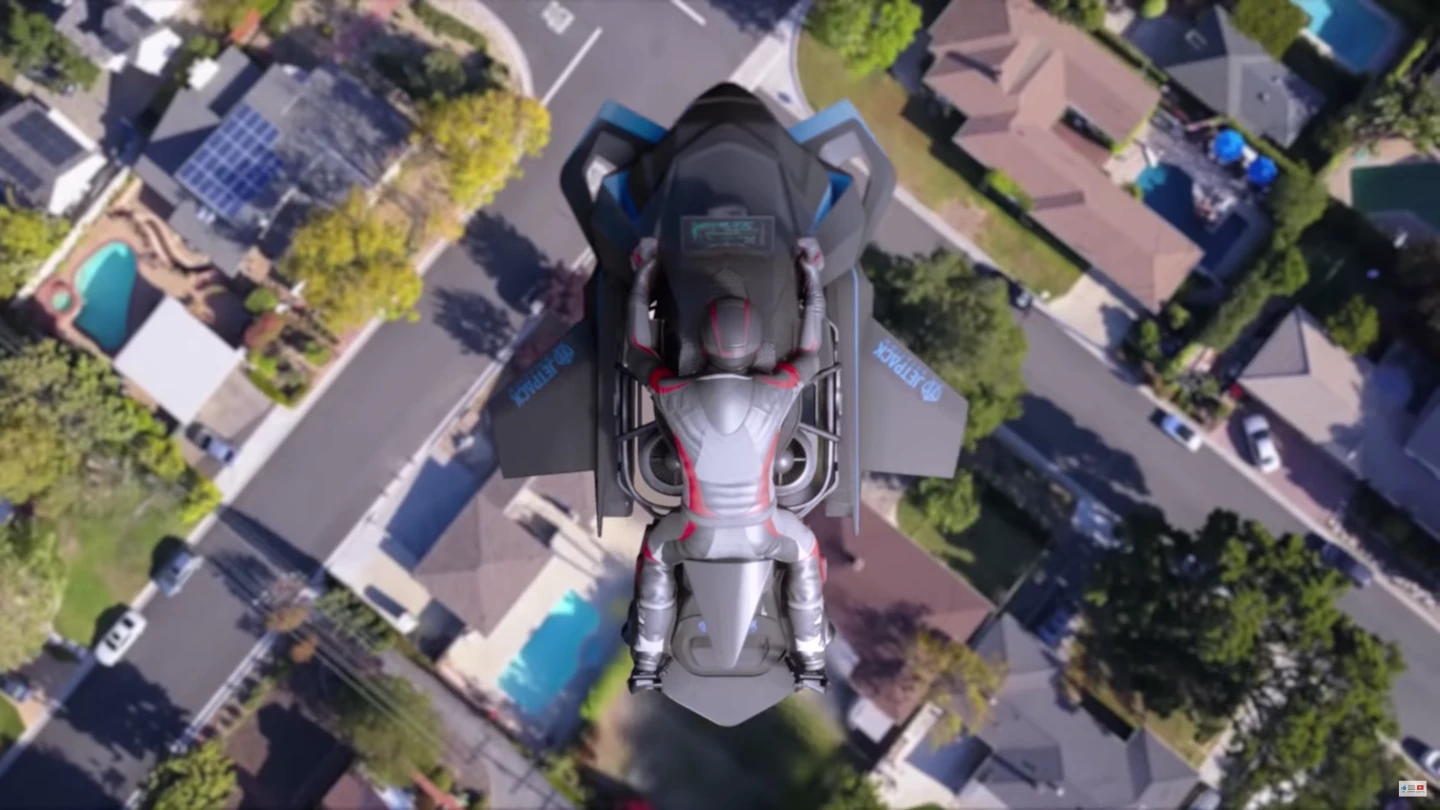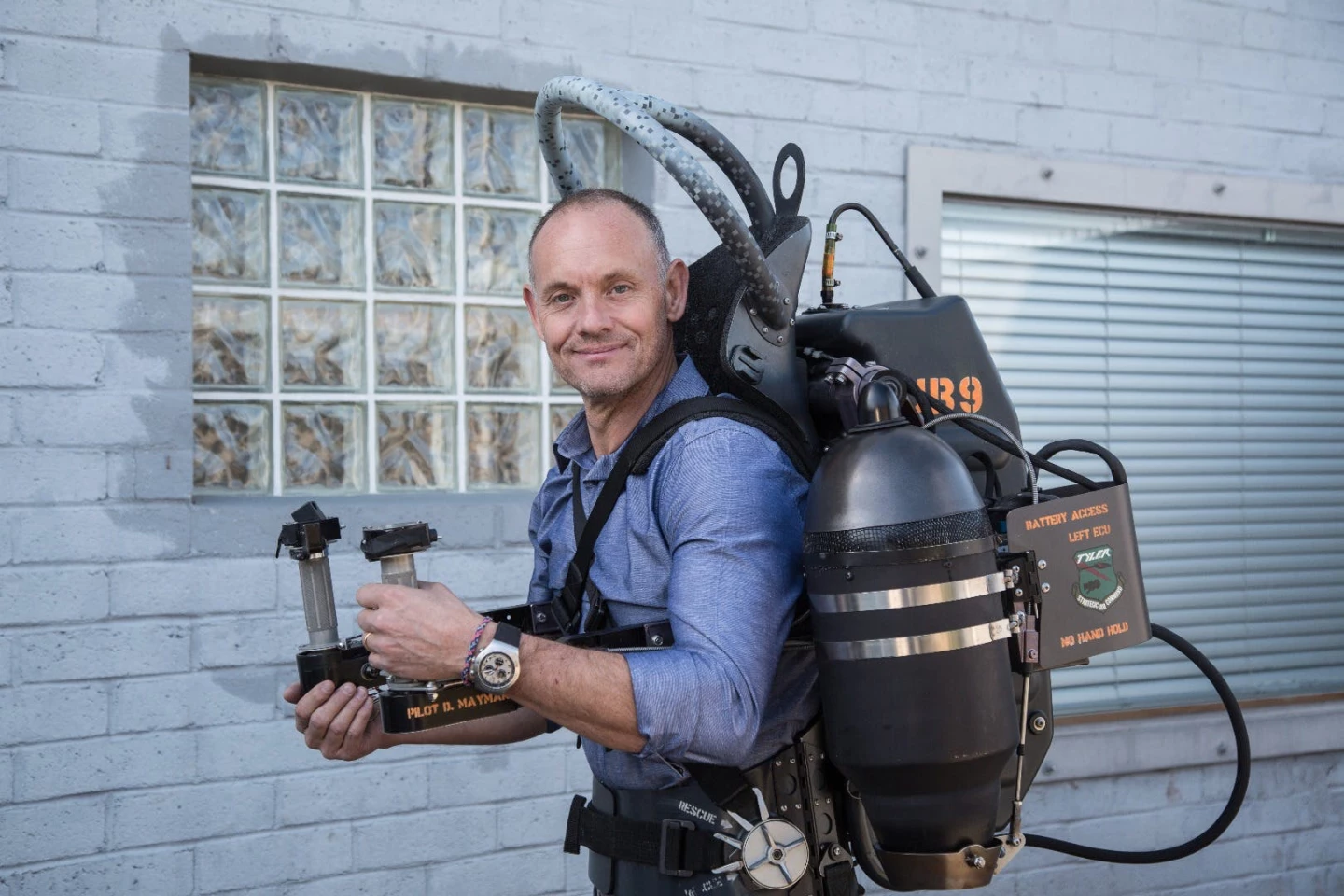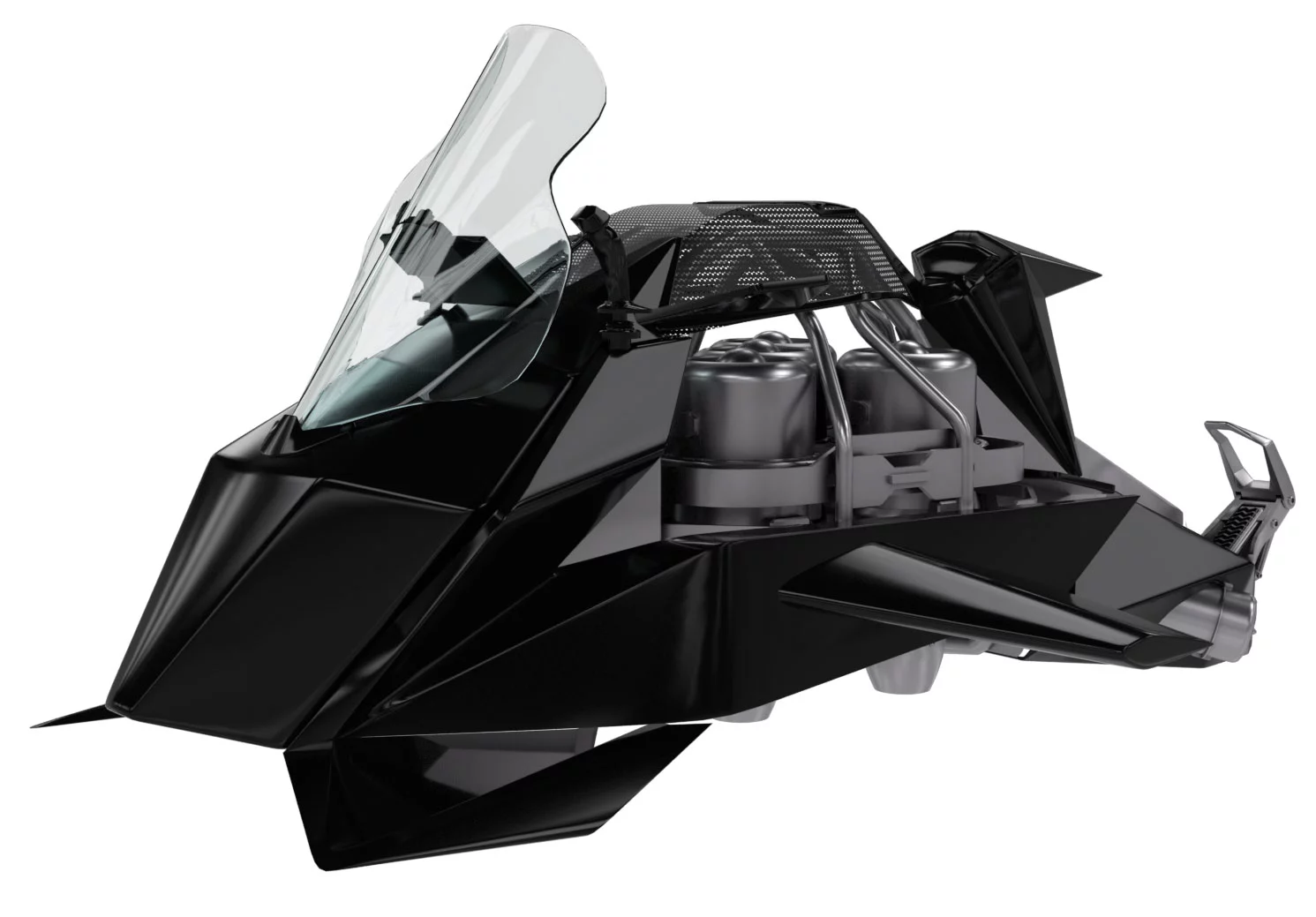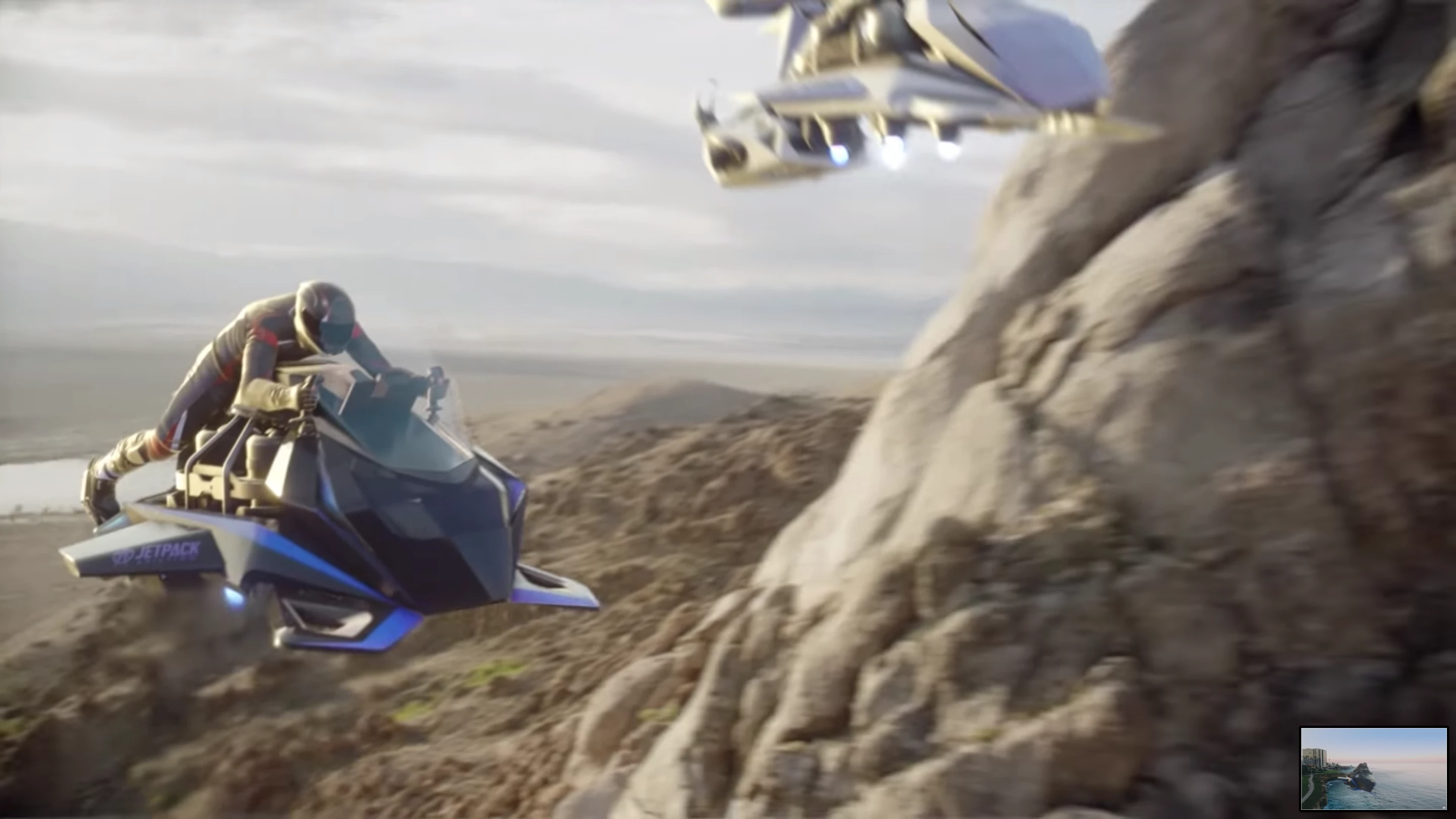With his crazy jetpack performance business growing and thriving, Australian innovator David Mayman is hoping to fry some bigger fish in the form of a Star Wars-inspired flying motorcycle. It's a very strange design, with the entire thing balanced on a central column of thrust from five turbine engines, all bunched together and gimbaled for balance and control. Last time we spoke, Mayman described the computer-controlled process of flying the thing as similar to balancing a pencil on the tip of your finger – and yet he's confident it'll work.
Having just been through the renowned YCombinator startup boot camp, Mayman has managed to raise the capital to take the Speeder concept through to a full-size prototype – and in the process, he's also starting to envision a fully-enclosed version that would be capable of upwards of 400 mph (644 km/h).
Mayman is always a wonderful interview – not to mention the subject of a terrific documentary film. His life as a personal aviation pioneer is absolute madness – we caught up this time just after he'd finished a dual jetpack performance in front of two million people at Huntington Beach, California, in which he and Jetpack Aviation's other lead pilot, Boris Jarry, had found themselves drenched with seawater from a firefighting display as they rocketed up and down the coastline. That's almost a regular day for Mayman by now, but he's wonderfully technically minded, and always open for a frank discussion, which is why I like to reproduce our chats at length. Hopefully it's as fun to read as it is to chat.
This time, Mayman discusses who's funding the Speeder flying motorcycle, what they're planning to do with it, the potential of a super-high-speed version, why he's sticking with jet turbines rather than looking at electric propulsion for now, where flying motorcycles might fit into the future VTOL transport mix, and his plans to fly both the Speeder and the jetpacks into the backs of moving planes one of these days ... what a life, eh!
What follows is an edited transcription.
Loz: So, who's ponying up the money to help you build these Speeders?
David Mayman: So at the back end of YCombinator, the accelerator program, we found some angels that got involved. They put up maybe 3 or 400,000. Then we just finished a seed round a couple of weeks ago for US$2,000,000, and that was led by Tim Draper at Draper Associates up in Silicon Valley. Pretty well known as a great moon shot investor – was one of the first investors in Tesla and SpaceX. He doesn't mind taking a hardware bet.
One of our other main investors is Jaan Tallinn, he was one of the early guys at Skype. He's based in Estonia, and also seems to love hard tech and mobility. There was a good fit there. Then we've got Boost VC, in Silicon Valley, and YCombinator themselves.

Loz: So a good mix of people to help push things forward?
I think awesome people in terms of understanding what it takes to be successful in aerospace. You can't take a short term view. It's not a software as a service.
Loz: What's the long-term vision you're pitching these guys?
The idea is that we finish the first prototype, in say nine to 14 months. The long-term vision will definitely be EMS (emergency medical services), probably starting with military EMS and medical services.
The way I pitched it to them, and they agreed, is that if we wait for certification for urban air mobility, we could be waiting a long time and spending a heck of a lot of money. So, instead of focusing on the concept of mobility on demand, focus on something that doesn't require immediate certification. That's the case for most military uses, it just doesn't require FAA oversight.
That doesn't mean the machines can't be built well – you still have to do all your modeling and study and whatnot, but you don't have to go through a certification process.
A conference I went to called Revolution Aero in San Francisco a month ago, the regulators were there, and the big airframe guys like Boeing, and a lot of investors in the room that have money in Lilium and what have you, and they were saying these things could cost you a billion dollars just to certify in the long term.
Loz: You're saying any individual airframe for an eVTOL air taxi could cost each company up to a billion dollars to certify?
Yep, to certify that airframe. Now, if you go and build an A380, it'll cost you a lot more than that. If you're Cessna and you're building your 20th version of a Citation, it may take you less than that. But if you're developing something completely new, this was the ballpark they were talking about. Even if it's half that, that's a massive amount of money for people to raise.
Who's going to fund that? Who's going to put up that kind of money? VC land? Private equity? Some kind of strategic alliance between the airframe makers? Nobody really knows, because they're not there yet. They're still building prototypes.
The other interesting stat is, seven years ago there were 10 players in the VTOL space, now there's something like 260. It's gone mad, everybody wants a piece.
Loz: Yeah, a piece of that opportunity to spend a billion dollars on paperwork! I was on the phone to Lilium a couple of weeks ago, and we glossed over certification, they said they didn't see any barriers to certification. The regulators are on board and trying to be helpful …
Maybe there aren't technical barriers, but it's a new airframe, a new type, a new variant. That's the intel we got from an industry group. So I don't know where that kind of money's going to come from. What VC's going to put that up?
Loz: For a technology the public will have to learn to trust …
Exactly. My focus is on building. I want to get this machine built, and I don't want to get stuck trying to raise however much it is, trying to go through the certification process, particularly when the customers that have demonstrated interest thus far, their use cases don't require certification in anyway.

So, this isn't initially about flying over houses and in cities and what have you, it's about flying in military operations in military environments.
An example is the Air Force Explore submission, which we put together a few weeks ago. And this is going to the edge of what's possible right now. They're looking at how we can deliver materials and equipment and supplies to a downed pilot, or isolated airman as they call it, anywhere in the world, within two hours of them ejecting from an aircraft. And probably from space – this might be delivered from space.
And I said "guys, what if we could drop something out of a C130, that could position itself somewhere, and it could land vertically, it could deliver equipment and supplies that an ejection seat doesn't have the capacity to carry, but guess what, it could also possibly extract that pilot. And just to suspend disbelief for a moment, what if we could fly that aircraft back into the back of the C130?"
There's no reason these days why that won't become possible. And that doesn't require certification.
Loz: That's some Mission Impossible-type Tom Cruise-ass sh*t.
Yep. It is right now, but we're talking right now about doing jetpack flights, manually flown, into the back of cargo planes in the air. So we're going to learn at some stage. (laughs)
A lot of parachutes on board, and some brave pilots in the C130 (laughs).
But going back to the pitch, the mid term is definitely this military and EMS idea of being able to deliver a couple of hundred kilos of anything to anywhere, or extract a person autonomously. The whole autonomous automation space is moving ahead so fast because of the huge investment going into motor cars, that there is no doubt this is something we'll be able to do. It's just a matter of how much more money we'd need to raise beyond the seed round to make it do all that.
The seed round will get us a prototype that's flying with a pilot, and also very basic autonomous maneuvers without a pilot. Come up into a hover, transition forward, stop, transition back, stop. No see and avoid, nothing fancy at this stage. That's the plan.
Further down the track, I'm still a firm believer that the ecosystem we have on the road will one day be mirrored in the air. There are four-, five-, six-, seven-seater SUVs on the road at the moment, and they fill a purpose. There's also mopeds, scooters and motorcycles on the roads at the moment and they fill another purpose. Rapid couriers, for instance.
I think in the future when we move to urban air mobility, there will be a place for a piloted craft where they have three to four passengers, and the economics will work for that. I also think there's a case for a one- or two-place vehicle that could either be autonomous or piloted, and probably a good deal faster than the eVTOLs.

Our position is, we're smaller, so we can land wherever. We don't have many moving parts, and we're faster in terms of airspeed. That's resonating, there's no doubt that everyone else is focusing on eVTOLs, with open rotor systems or tilt wings. We're sticking by our single-place or two-place vehicle.
They'll be turbojet powered initially. And the reason, as we're telling our investors, is that energy density isn't there yet with lithium ion or lithium polymer batteries. I still don't see any evidence that it's just around the corner. There were lots of discussions around this at Revolution Aero. Nobody is yet to say for sure that next year, or the year after, we'll be seeing huge improvements in energy density of batteries.
There are some eVTOLs out there right now that have raised a lot of money, that simply cannot fulfill their basic missions with energy density where it is right now. They're raising capital into the hope of a future energy density we don't have right now.
Loz: Is there much talk going on right now about hydrogen? Obviously, hydrogen has that energy density, as well as quick refueling … it's got its issues obviously.
Storage, that's the issue, it does have great energy density, as you say. But how do you store it? If you compress it as a gas, there needs to be something that can hold it. We haven't seen it commercially demonstrated yet. Maybe there's a bunch of people in stealth, and they're about to come out with stuff.
Loz: Obviously Toyota and Hyundai/Kia are trying to push hydrogen in the auto market, Korea's committing to a whole hydrogen economy, Australia's getting involved in energy exports via liquid hydrogen into that region, and Hyundai's just hired a bunch of guys from NASA to head up a flying car division … and then, of course, there's Alakai Skai out on the east coast saying that a liquid hydrogen fuel cell system will give them 400 miles of range on a five-seat multicopter that doesn't even have to transition to winged flight for efficiency. They're not bothering with wings, they can carry so much energy on board that they're happy to just burn it. Hydrogen stores something like 230 times more energy per kilogram than lithium, so there might be some real potential in fuel cell aviation. It's got me re-evaluating my stance on hydrogen.
I need to look at that again! But to your initial question, there's lots of talk around energy density at these conferences, but I've hardly heard hydrogen discussed at all. And hardly any talk about kerosene and turbojet engines like we're using, either! (laughs)
But for a lot of the aircraft in development right now, battery density does need to improve from where it's at. And when it does, we can easily move from turbojet engines to electric propulsion ourselves. Ninety-nine percent of the challenges we've got between now and the end of next year building the Speeder prototype are in stabilization. Once that's solved, the propulsion system, to some extent, isn't such a big issue.
Loz: Of course, there'll be some advantages in terms that it won't be so ferociously noisy.
Yep. And for some of the military use cases we're looking at, they don't care about noise at all. And on others, they do. When we did the first demonstration of the jetpacks to the Navy Seals out at Virginia Beach, they said "well, we ain't gonna sneak up an anybody, are we?"
Loz: (laughs) No kidding, the sound is like an F18, it goes right through you.
Yeah, maybe you'd send 10 of them in, and go for shock and awe and hope everyone just puts down their guns. (laughs)
But yeah, moving to electric propulsion makes sense for us at the right time. It's not up to us to spend the money to develop that technology, there's enough people doing that. And, of course, if you go to electric ducted fans, those are terrific for an aircraft that's flying, but they're not wonderful for static or low-speed air environments. So they're not great for VTOL, but they're great once you gain airspeed.
But we'd be more likely to move to electric ducted fans rather than an open rotor system. And speed is becoming interesting, in terms of the modeling we're doing on these initial concepts.

We're probably looking at two versions of the Speeder. One is a relatively slow version, if you could call 120 to 140-mph (193 to 225 km/h) slow, and it's a seating position very much like a motorcycle. Speaking with the marines expeditionary force, they're interested in it having different range requirements. Sometimes they want something really small, that maybe only needs to go 30 miles (48 km), that can fit into a small box on the back of a trailer behind a Humvee.
Other times they might want something capable of going 200 miles (322 km), and we could do that by extending the wings. Could we make the wings modular? Could we make them wet wings, with extra fuel stored in them? Yes we can. The issue becomes the aerodynamics of the wing as you transition from VTOL to winged flight. The same problems all the tilt wing eVTOL guys are trying to solve.
Loz: So, it becomes something kind of modular?
Right. Different wings you can bolt on and off. And we have a really small carbon fiber spar, there's no reason why we shouldn't be able to bolt on different sized wings.
Loz: Would you be sticking, then, with the same thrust arrangement of four or five engines gimbaled downwards?
Yeah.
Loz: You don't need something to propel you forward once the wing is in effect?
No. The plan at the moment, without giving away all of the secrets, is to use those engines also for forward propulsion, and not to have separate engines for that. The engines themselves will vector, and there'll also be some ducting of the thrust like we use on the jetpacks.
The engines are very close together. The beauty of that is that if one goes out, your asymmetric effect is minimized. The difficulty it creates is in things like yaw control; the further apart your engines are, the more yaw authority you have when you duct thrust.
So, that's the slow speeder, if you want to call it that. But then we started doing some initial modeling to figure out just how fast this could go. Even if we took the person out of it for the time being. We did a design all around maximizing airspeed. Probably changing the engine configuration a bit to give us a bigger horizontal component of thrust.
So, the guys banged around with models and numbers, and it turns out to be pretty damn fast. So, do we have something right now which is really the smallest and fastest VTOL possible? Imagine a world in the future where you've got something the size of a motorcycle that can take off vertically and go somewhere with an urgent whatever on board, at hundreds of miles per hour, and you could have hundreds of these things in the air, zipping back and forth, all self-separated.
That's a completely different market to the eVTOLs, even the ones that get onto a wing and go a couple of hundred miles an hour. We could go significantly faster than that. My guess is that there's a business case for that.
Loz: The sports car of the VTOL world.
Probably the hypercar. The Bugatti Veyron without the price tag, hopefully.
Loz: Without the price tag?!? It's going to need a bunch of turbine engines, and it'll need to be certified at some point, there'll be a price tag alright!
Maybe there's a Bugatti price tag initially, yeah, you're right. But there's things that need to be moved around really quickly, organs and the like. I'm sure there'll be a business case. This downed airman business, you don't want to be delivering things to that guy at 150 miles an hour, you want to be doing it at high speed, deploying from an airborne platform.

Loz: Does that lead to a different seating position? Obviously it'll have to be covered over, or else you'd better bring your sunglasses! (laughs)
Yes, it's a different vehicle, extremely streamlined. If it's piloted, the pilot would be completely reclined one way or the other.
Loz: It just depends on which bit you want to hit the ground with first if something goes wrong!
(laughs) Somebody else said that as well! Head first or feet first? But yes, a very different vehicle, the wing would be in a small delta shape, then you get all the issues of transitioning from VTOL up to a speed where you can use the benefits of such a small wing. There's no doubt, though, this is all possible. We won't be presenting that with the first prototype, that's for sure!
Loz: Do you have any image mockups that we can see?
We do … I'm not really ready to hand them out at this stage. The first step other than hiring our next two engineers is doing a formal trade study on the engine configuration. We're still making a couple of assumptions based on the one-quarter-scale electric ducted fan prototype. We're basing a lot of our assumptions on the way that flew, as well as some of the things it didn't do well. We have to finish the whole Matlab and Simulink modeling before we cut metal.
You've visited the workshop here before, you know how much I just love to cut metal and go and see how it flies. But this time, given the number of engines we've got, and how much they're going to cost and everything, I really want to see it flying on screen to a point before we cut metal.
The way we'll build the first airframe, we've got it designed up on CAD right now, will be very … modular's probably not the right word, but you can move the engines around on the airframe very easily. If I say to the guys let's start with the engines completely clustered, then we can move them in, lock them off and put them there.
It kind of looks like a scaffolding system, initially. Obviously not what we're showing on the videos yet. Hopefully we can get to the point where we're actually flying it. There's some interesting behaviors on Simulink right now, where if you transition too aggressively to forward flight, it gets into a porpoising, out of phase situation, which obviously we don't want.
Whatever we do with this aircraft, it needs to be able to take different sized people, different weights, the center of gravity can't be so critical that it struggles if they're a few centimeters fore or aft, or left or right. It's got to be able to cope with that.
Loz: That's the benefit of gimbaling things though, right? Because you can balance things more or less instantly?
Well, you don't want to get too far out, because you end up spilling thrust, even just to stay still. You're losing some of your vertical component of thrust just to stay still.
But that's the Speeder. So the next step for us is to get two more engineers on board who are guns with the simulation software, and we've got something like 500 candidates to get through after advertising the jobs.
Loz: I imagine each of these guys is nuttier than the last. You'd find some wonderful nerds!
I put a filter on our decision making process for excitement factor. We read all the resumes, and go through the cover letter, and we put a number on what their genuine level of excitement seems to be. That's what I want. Like Chris, our mechanical engineer. He hounded me to death, because he doesn't want to do anything but build jetpacks and flying motorbikes.
Loz: I think just get people to watch the documentary about you and say, seriously, are you up for this level of skin in the game?
That's very true! I'm not sure how many of the investors have seen the doco either. (laughs) It could go either way: either you're absolutely mad, and that's what we need because that's what it takes, or…
Loz: Or you're absolutely mad, keep your hands off my money! (laughs) You do spend a lot of the film saying "Christ, how am I going to find more money to throw at this?"
Yeah, well nothing changes! A couple of million dollars in aerospace is nothing. The big aerospace companies would spend that on a tiny modeling campaign, or more. To do things the traditional way, I'd spend nine months just doing modeling, and spend about three times that money before building a thing.

Loz: But you guys have a demonstrated ability to get things done on a shoestring, relatively speaking.
Exactly, and the investors have been really supportive. We've told them we're not going to model things until the cows come home, because we won't have enough money. And that's exactly what they say – the reason they're investing is because we make things happen, so go build it.
Loz: So, how much time have you got to get this thing up and running with that budget?
I would ideally like to have a prototype up and flying in whatever form, but demonstrating that a pilot can fly it, and that we can lose an engine, by the end of next year.
Even that, there's no doubt that's tight, Loz. If it was one of the big aerospace companies, it'd be three to five years and hundreds of millions of dollars.
Loz: Yeah, but those guys need things to work first time (laughs).
(laughs) That's true. The first thing we build doesn't have to be beautiful, either, it just needs to demonstrate that the thing flies, and that it can lose an engine, that it can demonstrate it can do the range, the speed, the endurance.
Loz: Will you be working with the same guys that supply the engines for the jetpacks?
Yeah. For the prototype, that makes sense. They're engines we know well, we know how quickly they speed up and slow down, which is important.
Loz: And you're already trusting them with your life on a regular basis.
Yes! Oh, and I forgot to mention, the JB-12 jetpack is nearly finished, so I'm about to start flight-testing the sh*t out of that.
Loz: That's the one with six turbines instead of two?
Yes. JB-11 was six turbines as well, but JB-12 has them reconfigured. They're in little triangle configurations on each side rather than in-line. And it's got a completely new computer system that's taken us a year to build.
It's genuinely triply redundant, you can fry any of the motherboards; there's six motherboards on it and it'll fly on any one of them. I'd love to show you that sometime if you're ever over in LA. You're always welcome!
Source: Jetpack Aviation














